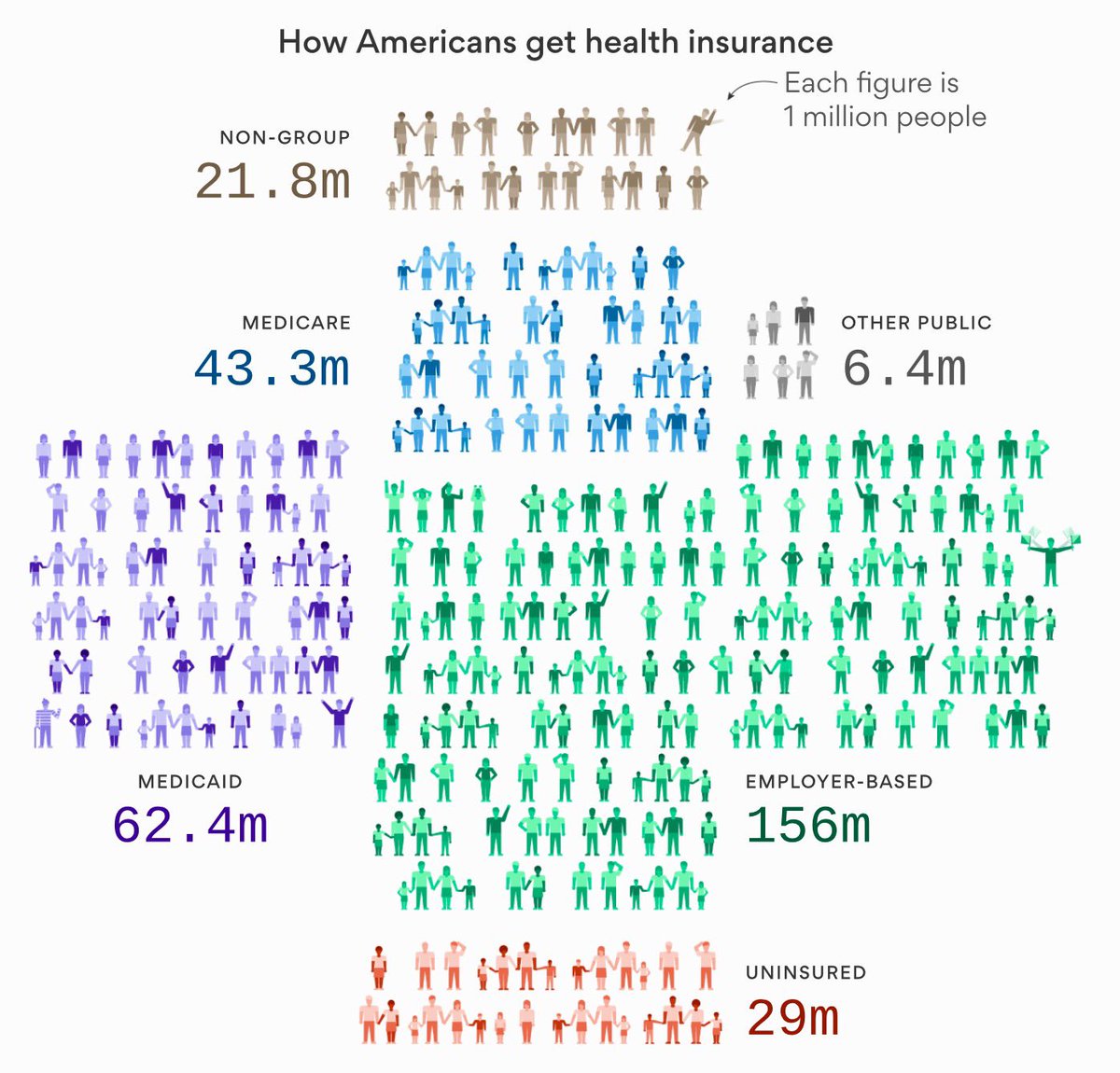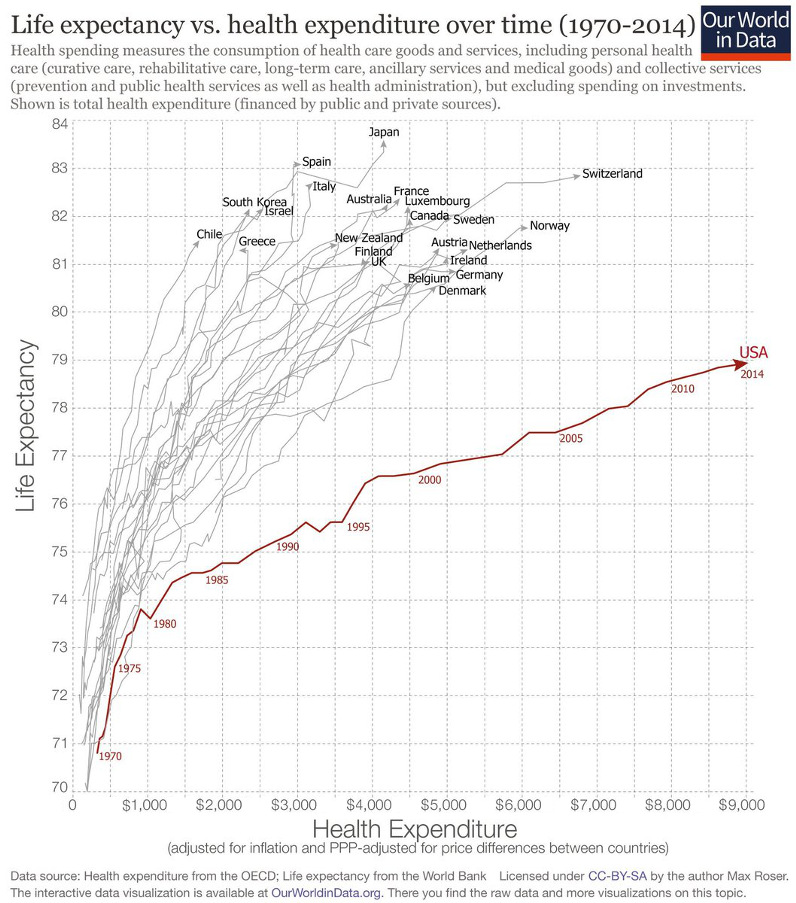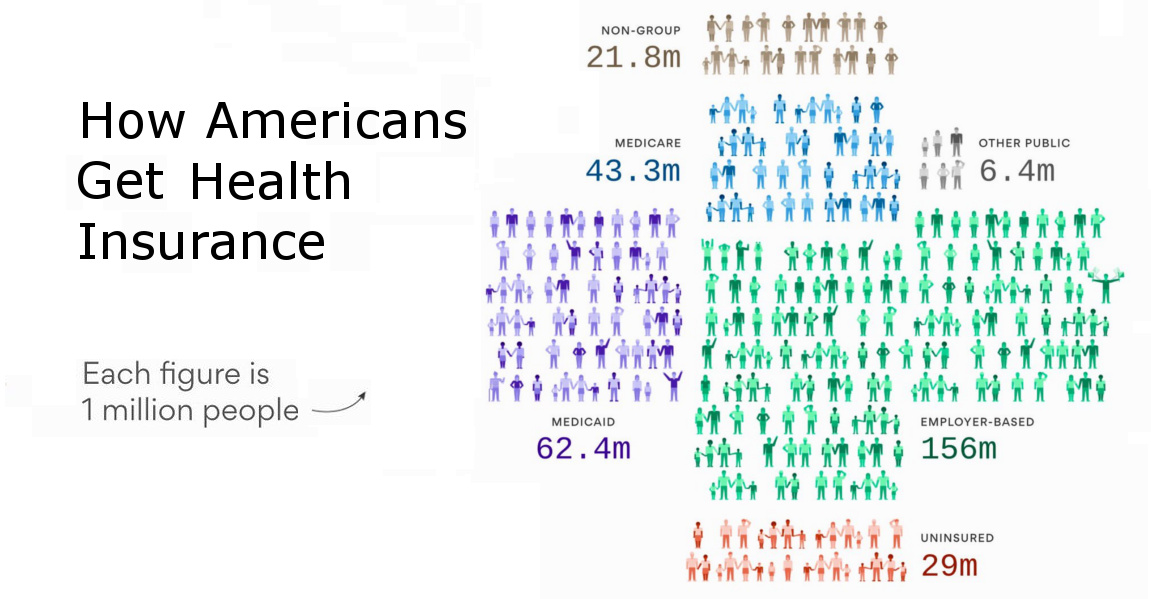While there is no shortage of opinions on the best route forward, the timeliness of the debate also gives us an interesting chance to dive into some of the numbers around healthcare – namely how people even get coverage in the first place.
How Americans Get Healthcare
The following infographic shows a breakdown of how Americans get healthcare coverage, based on information from Census Bureau’s surveys. Put together by Axios, it shows the proportion of Americans getting coverage from employers, Medicaid, Medicare, non-group policies, and other public sources. The graphic also includes the 9% of the population that is uninsured, as well.
The following definitions for each category above come from the Kaiser Family Foundation, a non-profit that uses the Census Bureau’s data to put together comprehensive estimates on healthcare in the country: Employer-Based: Includes those covered by employer-sponsored coverage either through their own job or as a dependent in the same household. Medicaid: Includes those covered by Medicaid, the Children’s Health Insurance Program (CHIP), and those who have both Medicaid and another type of coverage, such as dual eligibles who are also covered by Medicare. Medicare: Includes those covered by Medicare, Medicare Advantage, and those who have Medicare and another type of non-Medicaid coverage where Medicare is the primary payer. Excludes those with Medicare Part A coverage only and those covered by Medicare and Medicaid (dual eligibles). Other Public: Includes those covered under the military or Veterans Administration. Non-Group: Includes individuals and families that purchased or are covered as a dependent by non-group insurance. Uninsured: Includes those without health insurance and those who have coverage under the Indian Health Service only.
Healthcare Mix by State
Here’s another look at how Americans get healthcare coverage on a state-by-state basis. This time the graphic comes from Overflow Data and it simply shows the percent of buyers in each state that receive health coverage from public sources:
Oddly, the state that gets the highest proportion of public health coverage (New Mexico, 46.6%) is kitty-corner to the state with the lowest proportion of public health coverage (Utah, 21.3%).
Why the Debate is Paramount
If you ask some people what is going on with U.S. healthcare, they will tell you that things are going “sideways” – that costs are going up, but care is not improving anywhere near the same pace. Here’s a graphic we published last year from Max Roser that puts this sentiment in perspective:
It’s fair to say that care has been going sideways in the U.S. for some time, and the stakes couldn’t be higher. So, what needs to be done to fix the problem?
on Even while political regimes across these countries have changed over time, they’ve largely followed a few different types of governance. Today, every country can ultimately be classified into just nine broad forms of government systems. This map by Truman Du uses information from Wikipedia to map the government systems that rule the world today.
Countries By Type of Government
It’s important to note that this map charts government systems according to each country’s legal framework. Many countries have constitutions stating their de jure or legally recognized system of government, but their de facto or realized form of governance may be quite different. Here is a list of the stated government system of UN member states and observers as of January 2023: Let’s take a closer look at some of these systems.
Monarchies
Brought back into the spotlight after the death of Queen Elizabeth II of England in September 2022, this form of government has a single ruler. They carry titles from king and queen to sultan or emperor, and their government systems can be further divided into three modern types: constitutional, semi-constitutional, and absolute. A constitutional monarchy sees the monarch act as head of state within the parameters of a constitution, giving them little to no real power. For example, King Charles III is the head of 15 Commonwealth nations including Canada and Australia. However, each has their own head of government. On the other hand, a semi-constitutional monarchy lets the monarch or ruling royal family retain substantial political powers, as is the case in Jordan and Morocco. However, their monarchs still rule the country according to a democratic constitution and in concert with other institutions. Finally, an absolute monarchy is most like the monarchies of old, where the ruler has full power over governance, with modern examples including Saudi Arabia and Vatican City.
Republics
Unlike monarchies, the people hold the power in a republic government system, directly electing representatives to form government. Again, there are multiple types of modern republic governments: presidential, semi-presidential, and parliamentary. The presidential republic could be considered a direct progression from monarchies. This system has a strong and independent chief executive with extensive powers when it comes to domestic affairs and foreign policy. An example of this is the United States, where the President is both the head of state and the head of government. In a semi-presidential republic, the president is the head of state and has some executive powers that are independent of the legislature. However, the prime minister (or chancellor or equivalent title) is the head of government, responsible to the legislature along with the cabinet. Russia is a classic example of this type of government. The last type of republic system is parliamentary. In this system, the president is a figurehead, while the head of government holds real power and is validated by and accountable to the parliament. This type of system can be seen in Germany, Italy, and India and is akin to constitutional monarchies. It’s also important to point out that some parliamentary republic systems operate slightly differently. For example in South Africa, the president is both the head of state and government, but is elected directly by the legislature. This leaves them (and their ministries) potentially subject to parliamentary confidence.
One-Party State
Many of the systems above involve multiple political parties vying to rule and govern their respective countries. In a one-party state, also called a single-party state or single-party system, only one political party has the right to form government. All other political parties are either outlawed or only allowed limited participation in elections. In this system, a country’s head of state and head of government can be executive or ceremonial but political power is constitutionally linked to a single political movement. China is the most well-known example of this government system, with the General Secretary of the Communist Party of China ruling as the de facto leader since 1989.
Provisional
The final form of government is a provisional government formed as an interim or transitional government. In this system, an emergency governmental body is created to manage political transitions after the collapse of a government, or when a new state is formed. Often these evolve into fully constitutionalized systems, but sometimes they hold power for longer than expected. Some examples of countries that are considered provisional include Libya, Burkina Faso, and Chad.



















